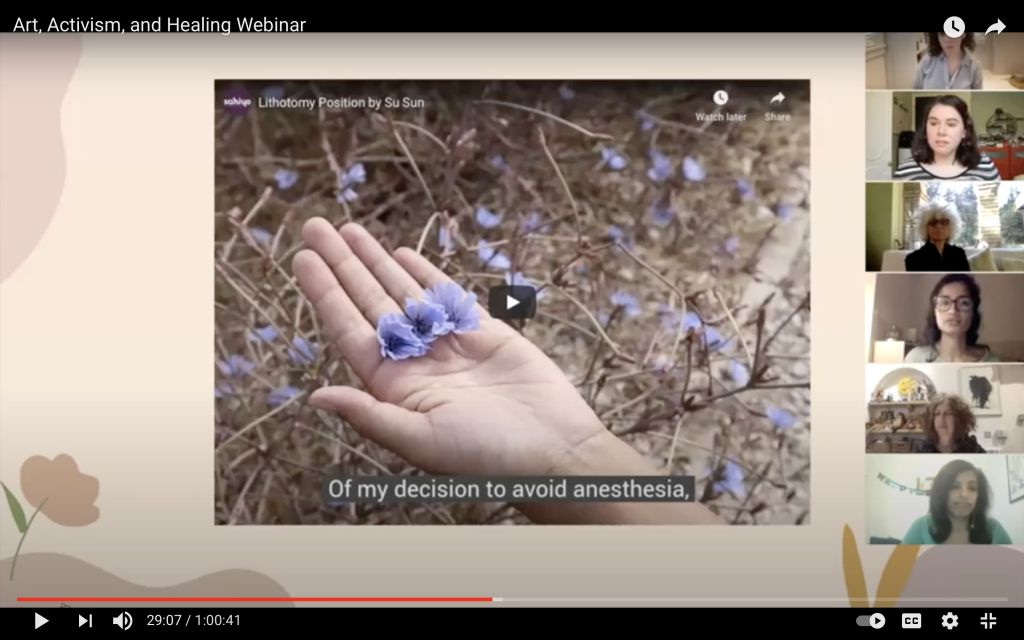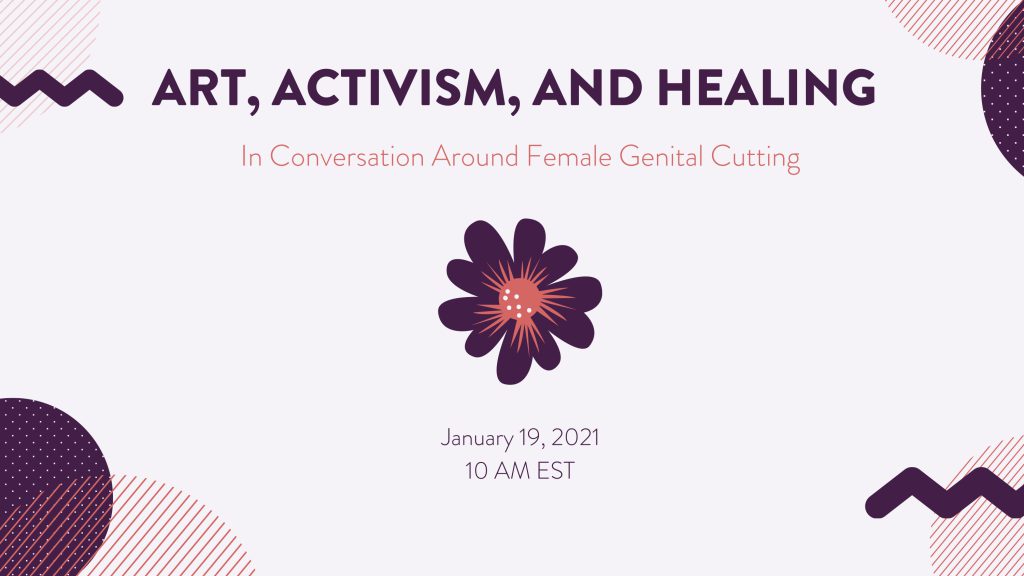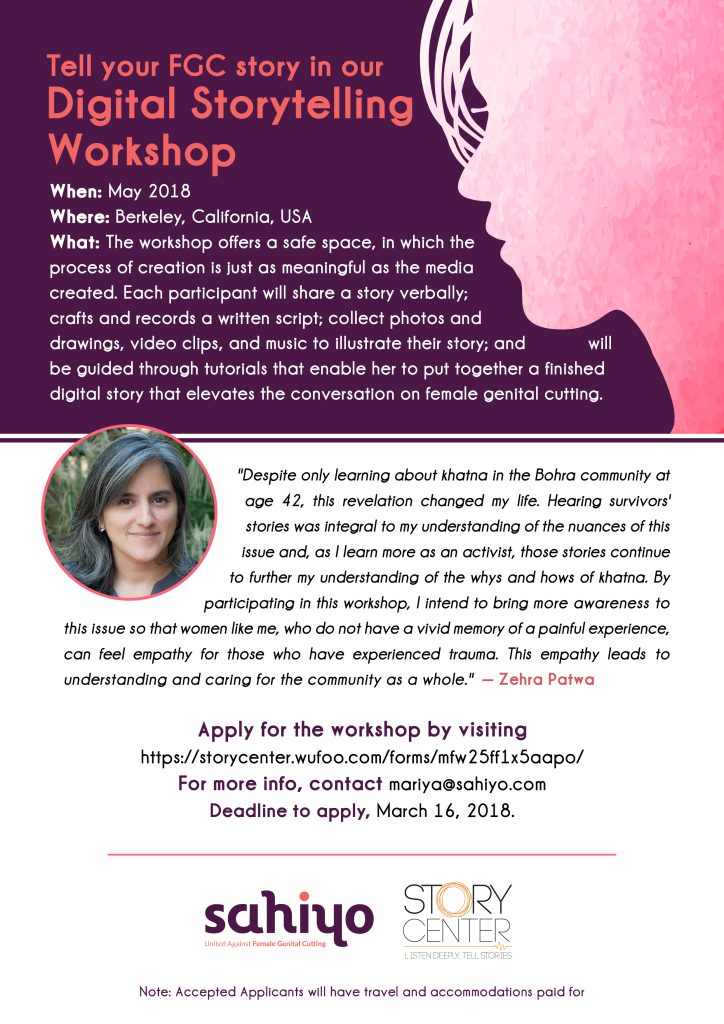Art, Activism, And Healing: Reflecting on our conversation around female genital cutting

By Cate Cox On January 19th, Sahiyo held the webinar, Art, Activism, And Healing: In Conversation Around Female Genital Cutting (FGC). During this webinar, we had the opportunity to hear from four speakers Owanto, Naomi Wachs, Sunera Sadicali, and Andrea Carr about how they have used art as a tool to encourage the abandonment of FGC and to work toward healing. From sculptures to videos and sound bites, this webinar explored how art in all its many forms can be used to uplift the voices of survivors and continue to push the conversation around FGC. Mariya Taher, a co-founder of Sahiyo and U.S. Executive Director, began our webinar by giving the audience an introduction to Sahiyo’s many programs that involve art and activism, including Sahiyo’s Voices to End FGM/C and #MoreThanASurvivor campaigns. Next, our speakers Owanto and Andrea Carr introduced us to their work as career artists, and how they are championing this cause in some of the most prestigious galleries and institutions around the world, as well as in community settings. They reminded us that art can be a tool to spark hard discussions and give people the space to have their own stories seen and heard. Sunera Sadicali and Naomi Wachs helped to expand on that conversation by taking us through their own journeys and explaining the psychological reasons behind why art is such an effective tool for trauma healing. The insight and experience of our panelists not only helped our audience to understand what has been done in the field of art and activism surrounding FGC, but stood as an inspiration for how we all can engage in art and activism in our own personal lives. At the end of our webinar, our audience had the opportunity to ask our panelists questions about their experience and knowledge. The questions explored how our panelists were able to get people to open up about their experiences with FGC and how they were able to use art to encourage education and conversation around this issue. Coming from their multi-disciplinary backgrounds, each of our panelists were able to speak to a unique aspect of these questions. Despite their diversity of experience, they each emphasized the importance of art as a conversational medium, that allows people to take control of their own narrative, and when a safe space is created, encourages healing. Art, Activism, And Healing: In Conversation Around Female Genital Cutting (FGC) explored the often underutilized tool that is art to empower communities to abandon FGC and support survivors’ healing. It reminded us that activism and healing take many forms, and that, as Owanto said, “There is light.” For those who are interested in learning more about art and activism, Sahiyo is hosting a screening of our Voices to End FGM/C videos coming up this February. You can register here to attend! If you were unable to attend this webinar, or would simply like to learn more about this event, the transcript and recording of this event are attached below. Watch the recording of this event. Read the transcript.
Art, Activism, and Healing webinar: In Conversation Around Female Genital Cutting

By Cate Cox Across the world, millions of women and girls are at risk of female genital cutting (FGC). FGC can have severe physical and psychological impacts that last a lifetime. As the painful effects of FGC are brought to light more and more, activists and therapists alike are looking for more ways to support survivors and protect future girls from this practice. Art is an underutilized tool to create awareness about this issue and support survivors’ healing. As an organization whose mission is to use storytelling to empower communities to abandon FGC and support survivors’ healing, Sahiyo is one of the key advocates for utilizing art as a means of supporting these effectors. From the Voices To End FGM/C campaign, the #MoreThanASurvivor collages, and the Faces for Change project, art and activism have long been part of Sahiyo programming. On January 19th, 10 a.m. EST, Sahiyo will be hosting the webinar, Art, Activism, and Healing: In Conversation Around Female Genital Cutting. During this inspiring event, you’ll hear from four expert panelists, Owanto, Andrea Carr, Sunera Sadicali, and Naomi Wachs, as they discuss art and its role in supporting survivors’ healing, how activists and survivors alike can use art to make a change in their communities, and working toward prevention efforts to end female genital cutting. Following the vein of one of our previous webinars, Moving Towards Sexual Pleasure and Emotional Healing, the speakers will first introduce their work and their personal journeys related to this subject and then we will have a question and answer session led by Sahiyo co-founder Mariya Taher. To hear more about how art can help you as a survivor and/or an activist, please register for the event. This event is open to anyone who wishes to attend. Register Today: https://bit.ly/ArtActivismAndHealing Owanto is a multi-cultural Gabonese artist born in Paris, France. She was raised in Libreville, Gabon, and later moved to Europe to study philosophy, literature, and languages at the Institut Catholic de Paris in Madrid, Spain. Her multidisciplinary practice emerges from a 30-year career where she explores a variety of media, including photography, sculpture, painting, video, sound, installation, and performative works. Her practice enables her to engage with consciousness through the notion of memory, both personal and collective. Andrea Carr has worked across a broad spectrum of the performing arts, bringing vitality to global ecological and social themes. Embracing change along the way, her work often distills into designs that move between art installations and immersive environments. Her work has been included in the U.K. representation of the World Stage Design Exhibition, in the Aesthetica Art Prize anthology, and in the ‘Designers Lead’ section of the Society of British Theatre Designers (SBTD) 2019 exhibition at the V&A. Andrea is also studying Process Orientated Psychology. She works from her Peckham Studio, her ‘dream palace,’ where she goes to ground her ideas, make models and mock-ups, and as a space for collaboration. Sunera Sadicali was born in 1982 in Mozambique and later moved to Lisbon. She grew up in a family that was part of the Bohra Community; they were (and still are) the only members in Portugal/Iberic Peninsula. She underwent female genital cutting, or khatna, at the age of 8 in Pakistan, while visiting her grandparents on vacation. She moved to Spain to study medicine at the age of 19 and finished her Family Medicine residency in Madrid. Since 2015, she has lived and worked in the south of Sweden with her partner and three lovely kids. She has been politically active since the birth of her second child in 2012, with a focus on women’s issues, decolonial feminism, anti-racism, and healthcare activism. Naomi Wachs has a B.S. in Theater from Northwestern University and a Masters in Social Work (A.M.) from the University of Chicago’s School of Social Service Administration. While at S.S.A., her concentration was in clinical social work with a focus on art-based methods, LGBTQ affirmative practice, and trauma-informed practice. From 2015-2017, as a German Chancellor Fellow with the Alexander von Humboldt Foundation under the guidance of Tobe Levin von Gleichen, she explored art-based practices as a tool for trauma healing and restorative dialogue with immigrant and refugee communities affected by FGM/C and other forms of gender-based violence. Currently, Ms. Wachs is a psychotherapist at Connections Health in the Chicagoland area where she works with individuals, couples, families, and groups with anxiety, depression, trauma, eating disorders, and relationship and identity concerns. This event is sponsored by Sahiyo.
Voices Series: Why I create art that evokes hope for survivors of FGM/C

This blog is part of a series of reflective essays by participants of the Voices to End FGM/C workshops run by Sahiyo and StoryCenter. Through residential and online workshops on digital storytelling, Voices to End FGM/C enables those who have been affected by female genital mutilation/cutting to tell their stories through their own perspectives, in their own words. By Musfira Shaffi Working on this project was challenging in many ways. Anyone reading Rhobi’s words will immediately be struck by the strength and bravery in her story. My job was to merely complement it with imagery that would evoke a similar visceral reaction in the viewer. The responsibility of effectively conveying the sensitive subject matter is one that I struggled with, which is why I chose collage as a technique for visual storytelling. I wanted to fuse the private and the public, which is why I paired archival images from Rhobi’s childhood with royalty-free stock imagery, in order to depict the universality of her story. I used a severe palette of red, black and grey to affirm the physical and psychological trauma of female genital cutting. Rhobi’s story is in equal parts heartbreaking and exhilarating, which, in turn, inspired me to create a moving allegory that would evoke memory, violence, and finally, hope. [youtube url=”https://www.youtube.com/watch?v=TzcxkNzdGxk”] Learn more about the Voices project here.
Voices Series: How I found purpose through survivor’s stories

This blog is part of a series of reflective essays by participants of the Voices to End FGM/C workshops run by Sahiyo and StoryCenter. Through residential and online workshops on digital storytelling, Voices to End FGM/C enables those who have been affected by female genital mutilation/cutting to tell their stories through their own perspectives, in their own words. By Debasmita Dasgupta Working on this project has been life-changing. Not that I did not know about female genital mutilation/cutting (FGM/C), but talking directly to people who had to go through such traumatic experiences brought me closer to the truth. I was absolutely moved by the courage of two of the participants, who dared to speak up despite all odds. That courage is irresistible and I am sure it will continue to inspire many more souls like mine. I feel fortunate that I could tell their stories through my art. I am delighted that my art found a purpose. I am hopeful that my art will make an attempt to light up some of the dark corners of the world, where the peril of FGM/C still exists. In solidarity! Learn more about the Voices project here.
Voices Series: Why I, as an artist, collaborated with survivors of FGM/C

This blog is part of a series of reflective essays by participants of the Voices to End FGM/C workshops run by Sahiyo and StoryCenter. Through residential and online workshops on digital storytelling, Voices to End FGM/C enables those who have been affected by female genital mutilation/cutting to tell their stories through their own perspectives, in their own words. By Esther Elia As an artist, I wait for moments like the Voices to End FGM/C workshop with excitement and anticipation–moments where my passion can be linked with the passions of others to create projects that bring to light the true injustices of our world, including the traditions that have fallen through the cracks and deserve a critical eye. I got to collaborate with two women who have the foresight, courage, and self-awareness to question a tradition that has been taken for granted, and thrust it into the public eye so that others may also think critically about the effect FGM/C has on women. It was my great privilege to be a part of this project and create images that would impact the viewer, and most accurately reflect the storyteller. For a subject matter so wrought with strong emotion, simplicity of image became my strategy. The story was the main character, and my art functioned as the supporting characters, giving the main message its meaning. This is a project that I will always remember and be proud to have been a part of. Learn more about the Voices project here.
Calling for Visual Artists, Musician, Sound Designers, to assist with Sahiyo Stories Project in the U.S.

This May, 2018 Sahiyo Cofounder, Mariya Taher, will be working with StoryCenter on a digital storytelling project to capture the stories of women who have been experienced or affected by FGM/C. Here is an example of the story format that will be used — simple voiceover narration paired with images and video clips. The stories will be shared as a way of bringing attention to the need to end this practice, which continues to harm women and girls around the world. Sahiyo and StoryCenter are looking for talented visual artists (illustrators, photographers, videographers) to develop original visual images to use in the short videos that participants will be creating. They are also looking for talented sound designers and musicians who might be willing to contribute original music to include in the videos. The workshop will be in Berkeley, California, however, photographers and videographers do not necessarily need to be at the workshop; they might shoot creative b-roll video in their own locations, of scenes/things other than the storytellers. However, they are also considering the possibility of asking workshop participants to take part in short interviews so we capture how the experience of how the workshop is going for each of them. In this case, one videographer would need to be present at the workshop in May. If that person also wanted to help shoot some b-roll on site, that would be welcomed. If you or someone you know is interested in participating and supporting this important project, please contact Mariya at mariya@sahiyo.com. Please note that due to limited funds, Sahiyo Stories is seeking individuals who may be able to provide assistance on a pro-bono basis (though there may be a slight possibility of providing a small stipend). Sahiyo and StoryCenter would, of course, would ensure that your contribution is properly credited in our project (and on the participant videos produced). To learn more about the project, click here. To see an example of StoryCenter Video, click below [youtube url=”https://youtu.be/1GtBKX1a1fA”]A
FGM/C from an artist’s perspective: Art for cultural change

Art: A Tool for Healing and Dialogue with Communities Affected by FGM

By Naomi Rosen Female Genital Mutilation/Cutting (FGM/C), although often surrounded by secrecy and taboo, is now discussed more frequently in the media. Activist groups such as Sahiyo are taking great steps to heighten awareness and dialogue, within relational, familial, and community contexts, because the practice is often hidden, shameful, and the subject is therefore avoided. In many cultures and contexts, it is already difficult to talk about women’s bodies and women’s sexuality, but when talking about FGM/C, the discomfort and silence are compounded by generations of tradition, ideas about what it means to be feminine and pure, religious beliefs, and a multitude of other reasons dependent on geographical, cultural, religious, and personal contexts. Art is a helpful tool and medium in supporting communities affected by FGM/C to express and explore the topic of FGM/C in a way that feels less threatening and can allow for more openness and dialogue. Creative practices allow for what is secret and taboo to be brought to light. It encourages the exploration of what is unexplainable through words, and allows for the unheard to be spoken aloud, and for individuals to truly listen to and empathize with one another. Art can heal emotional wounds through the creation of meaning-making and metaphor. This year as a German Chancellor Fellow through the Alexander von Humboldt Foundation and under the guidance of Tobe Levin von Gleichen, I have been interviewing organizations and individuals in Germany, but also more broadly in Europe and the United States, to explore how the arts can serve as a tool for trauma healing and dialogue with communities affected by FGM/C and other forms of Gender-Based Violence. I have learned creative practices are utilized with communities affected by FGM/C and the unique role the arts can serve. The purpose of compiling this information through my various interviews is to create a handbook to support organizations, practitioners, and direct-service providers in utilizing art and creative approaches in their daily practice. The handbook seeks to expand the definition of “art” to include storytelling, gardening, cooking, and more. It will suggest unique ways to use the arts, from generating intergenerational dialogue to creating spaces for prevention and awareness-raising in gender violence. The resulting publication will also contain descriptions of the organizations I have interviewed and their contact information so that these organizations can be connected with one another and to other individuals for future collaboration and knowledge-sharing. While FGM/C is a custom that for generations has been hidden, the utilization of the arts can create the opportunity for healing from potential traumatic responses as a result of the practice, as well as fostering dialogue that may not be possible otherwise. For more information, please contact Naomi Rosen at naomirrosen@gmail.com For more information on Tobe Levin von Gleichen and her publishing company, UnCut Voices Press, visit the blog https://uncutvoices.wordpress.com ———————————————————————- Naomi Rosen lives in Frankfurt, Germany. After completing at B.S. in Theater at Northwestern University, she was a Northwestern University Public Interest Program Fellow (NUPIP), where she witnesses the role art and theater can play in healing and change in working with at-risk youth. She went on to pursue her Masters in Social Work at University of Chicago’s School of Social Service Administration where she specialized in Trauma-Informed Practice, Creative Arts Therapies, LGBTQ Affirmative Practice, and Multicultural, Multisystemic Practice with trainings at Live Oak Therapy Practice. Naomi is currently a German Chancellor Fellow through the Alexander von Humboldt Foundation where she is writing a handbook about arts-based methods to support communities affected by FGM and other forms of Gender-Based Violence.
